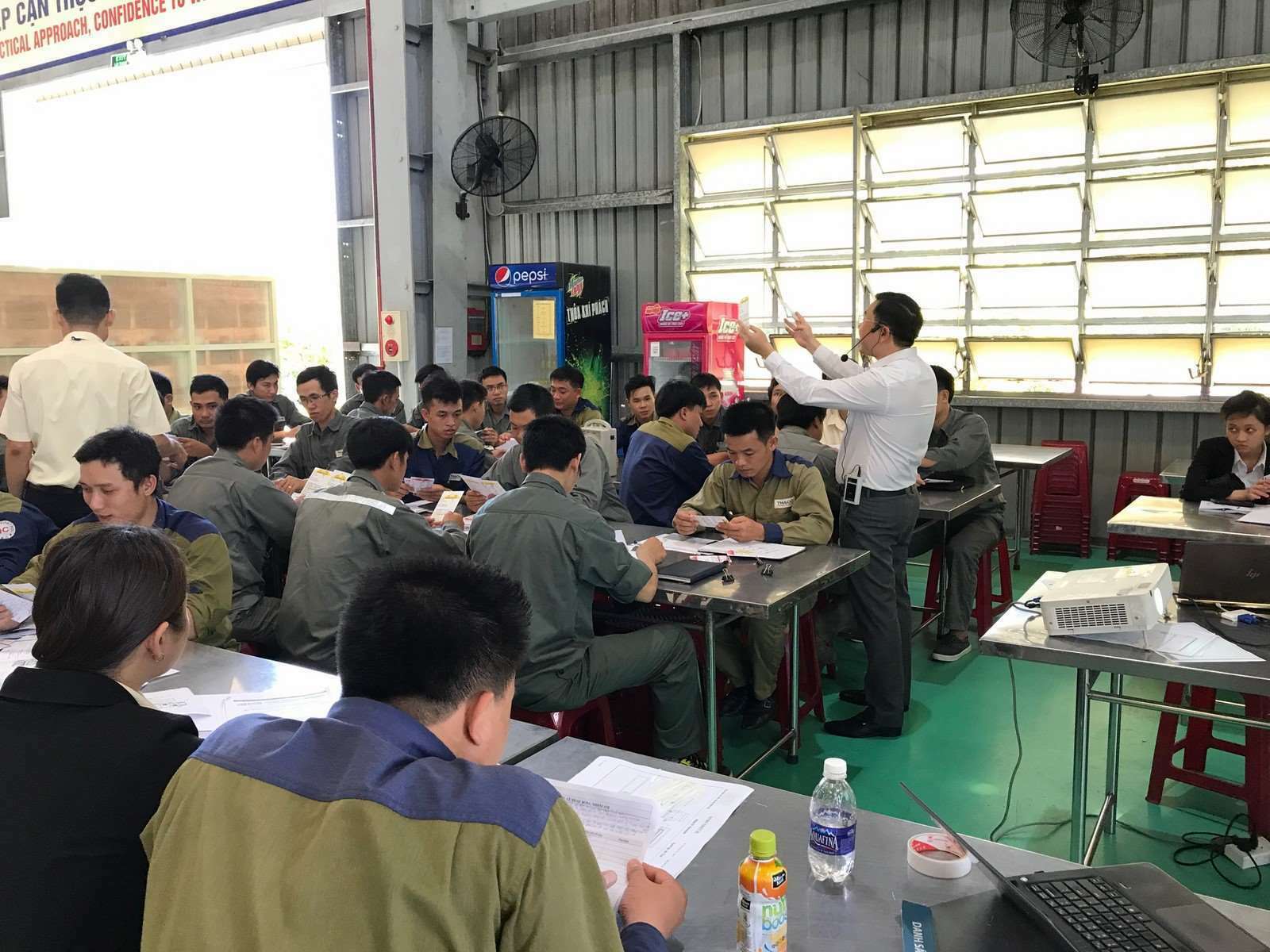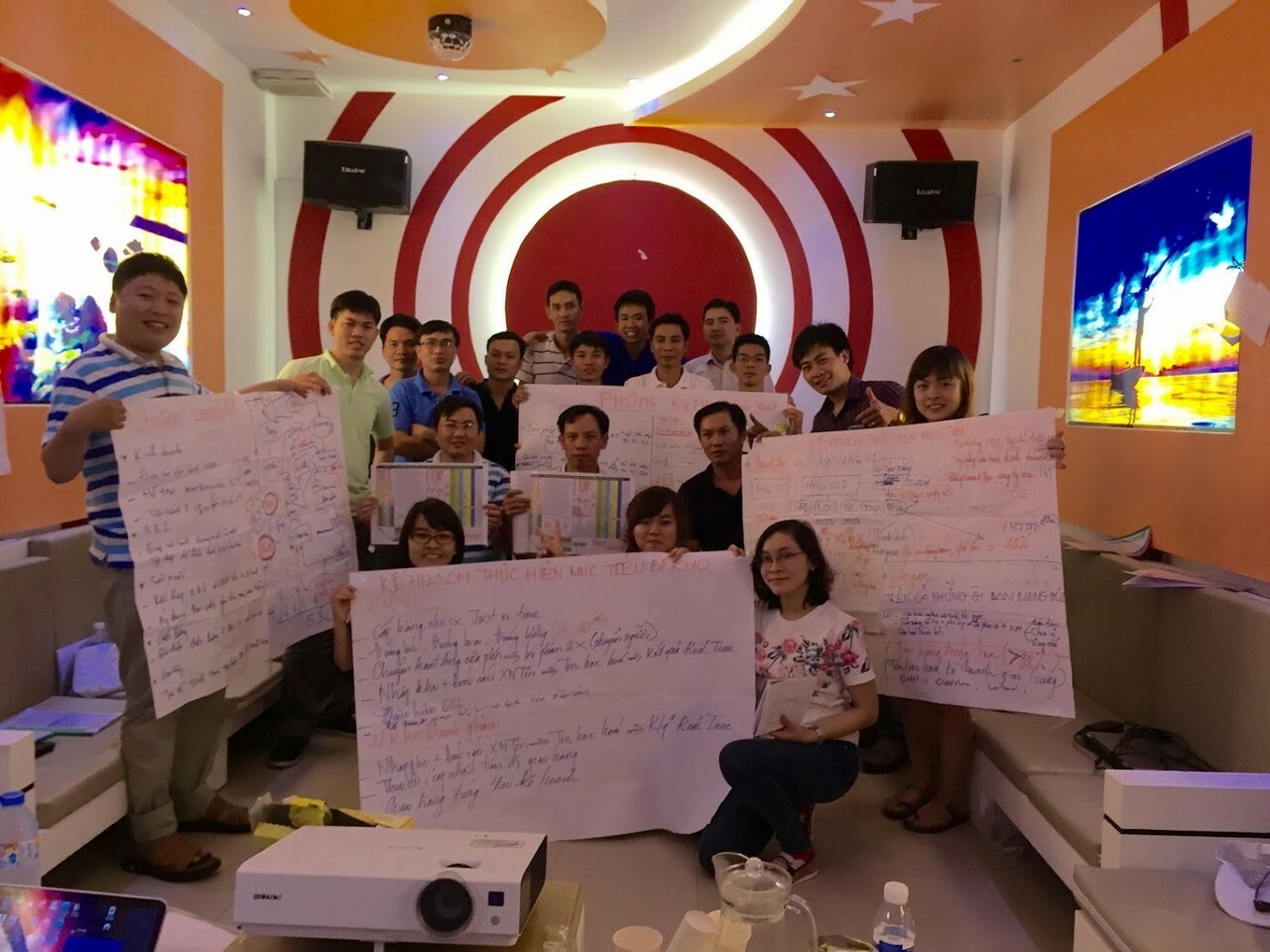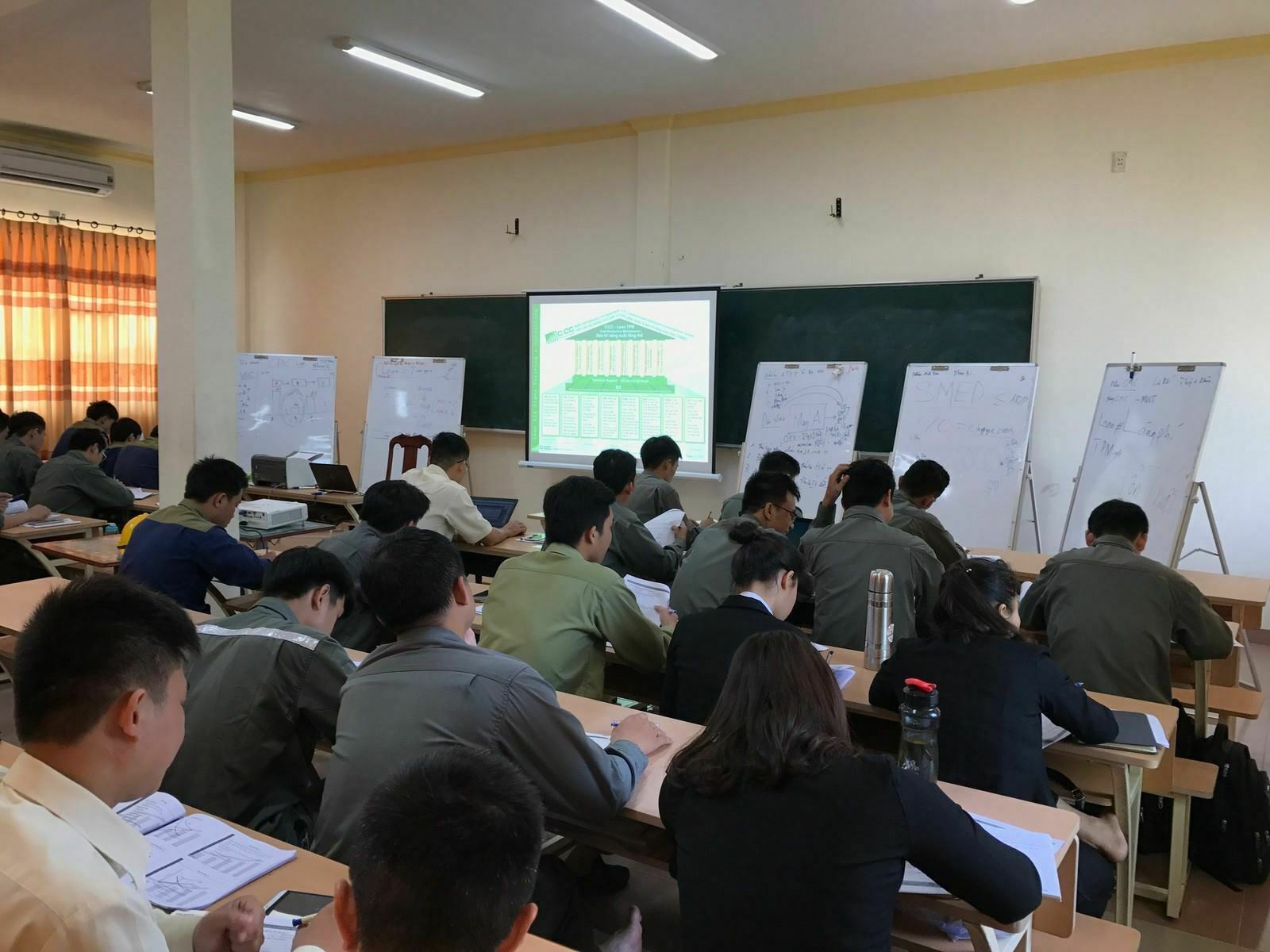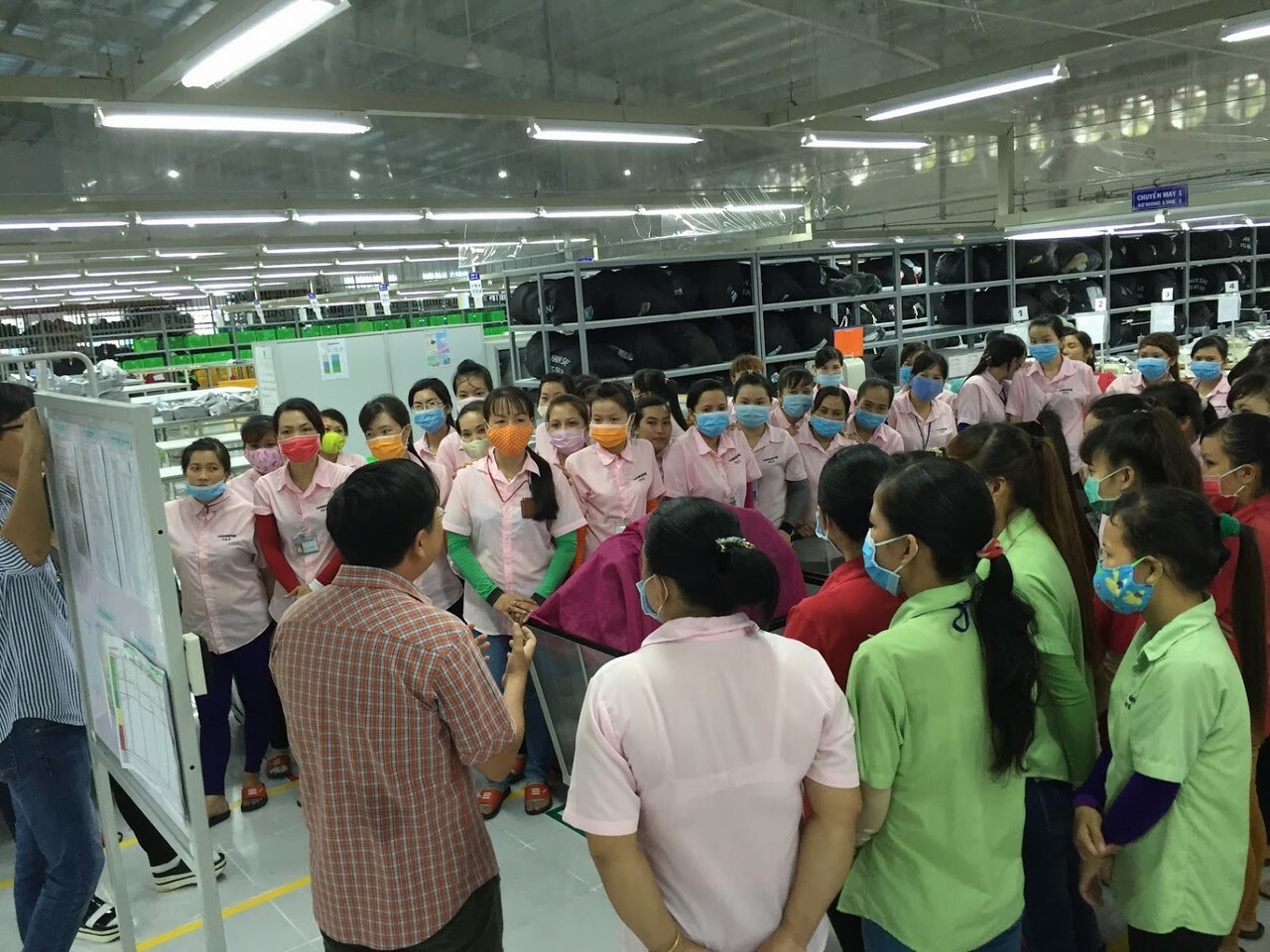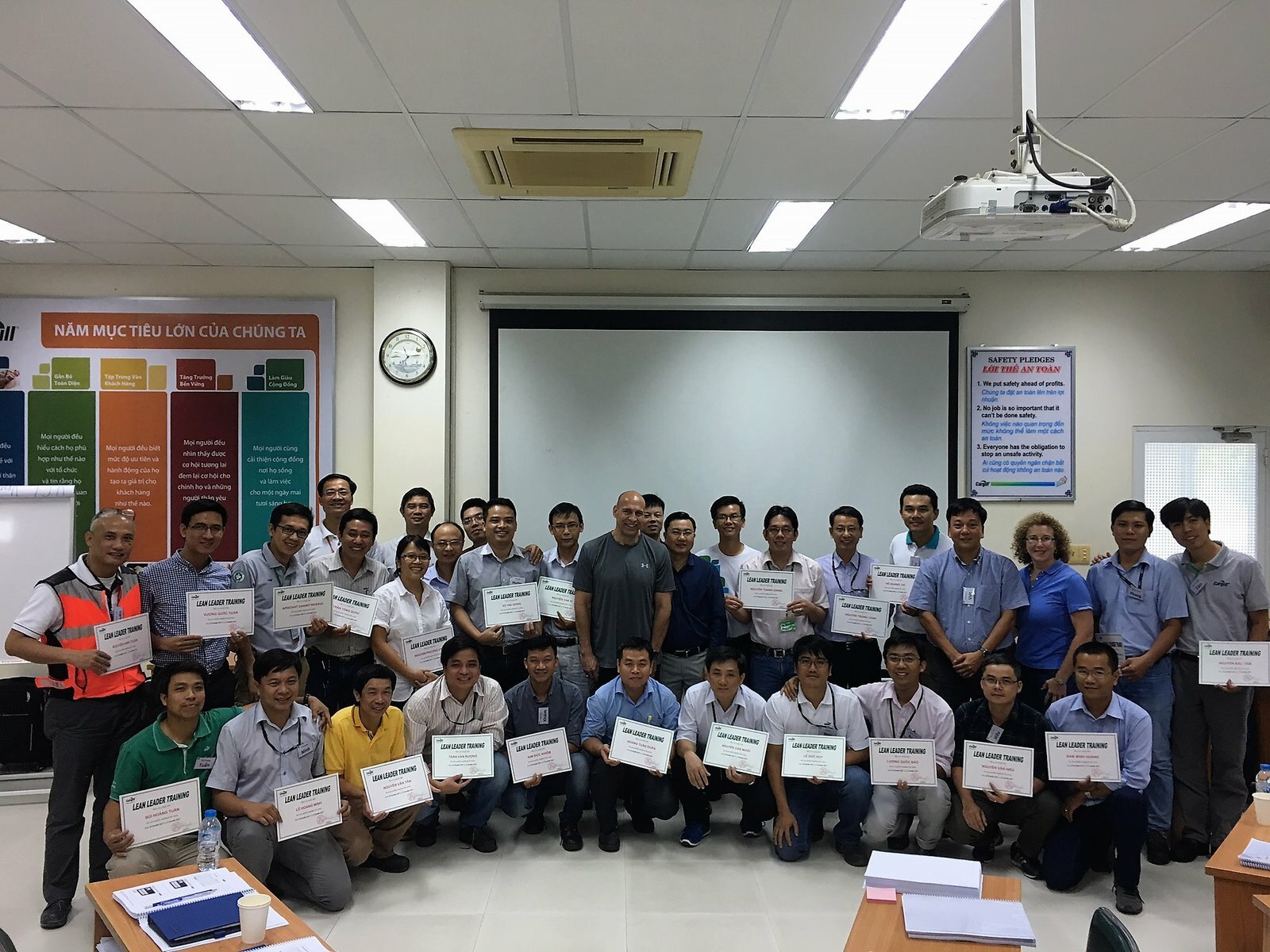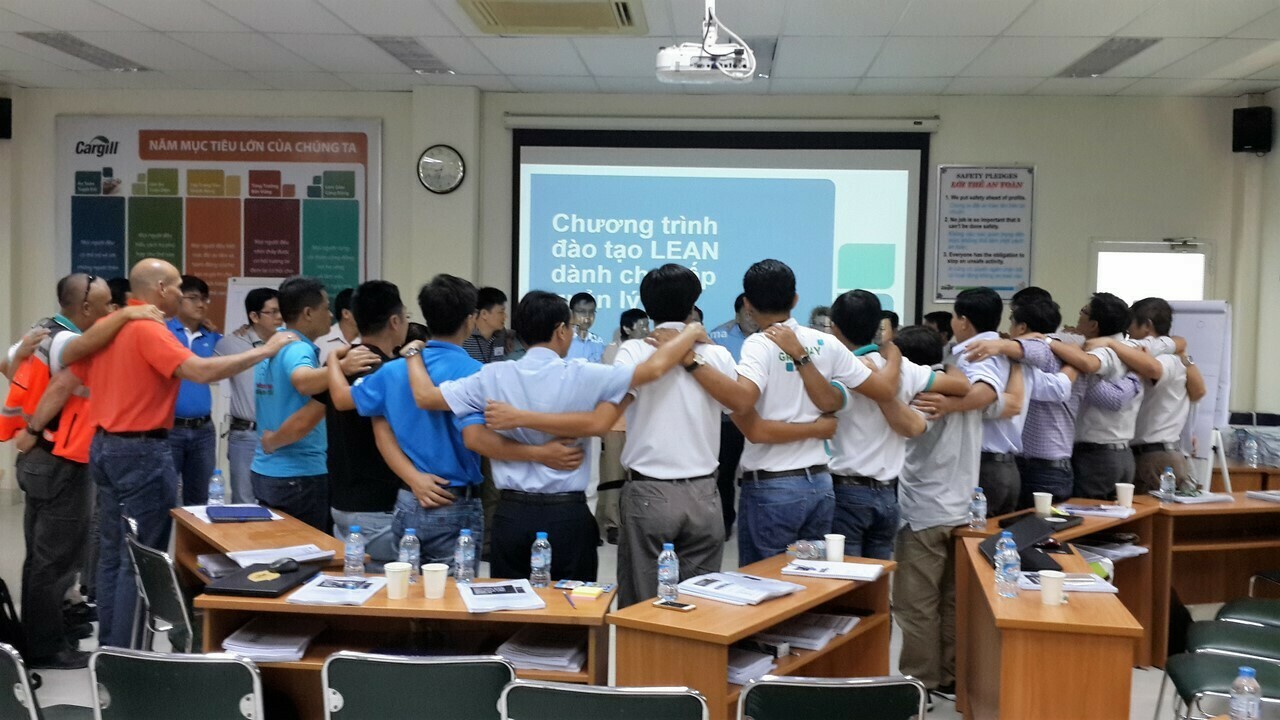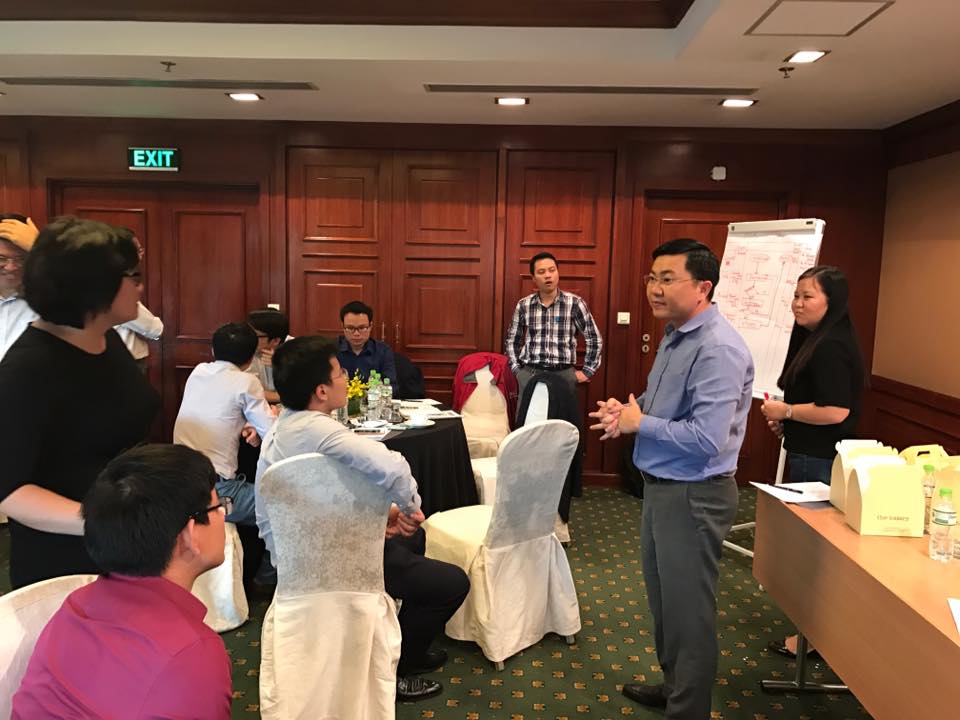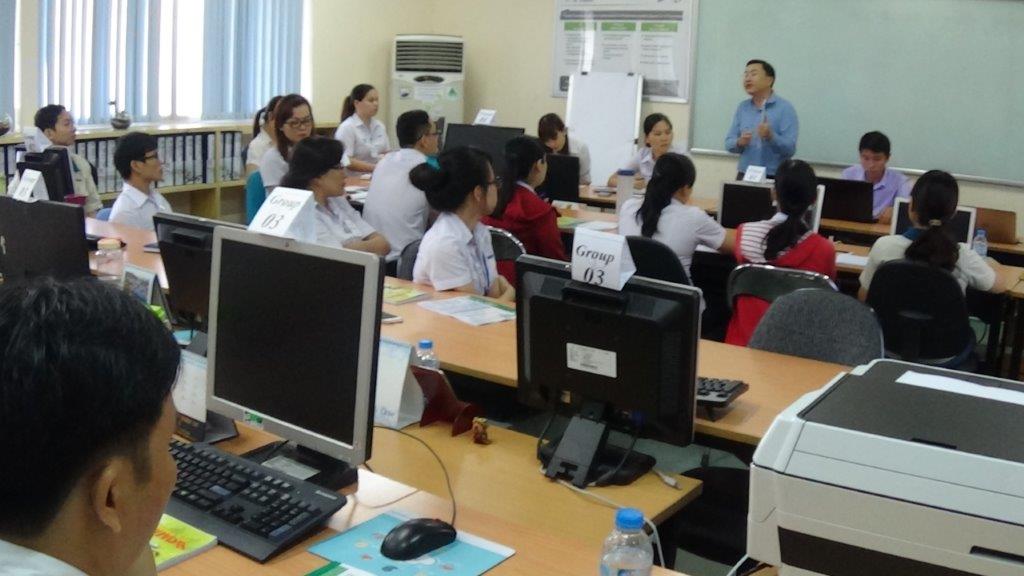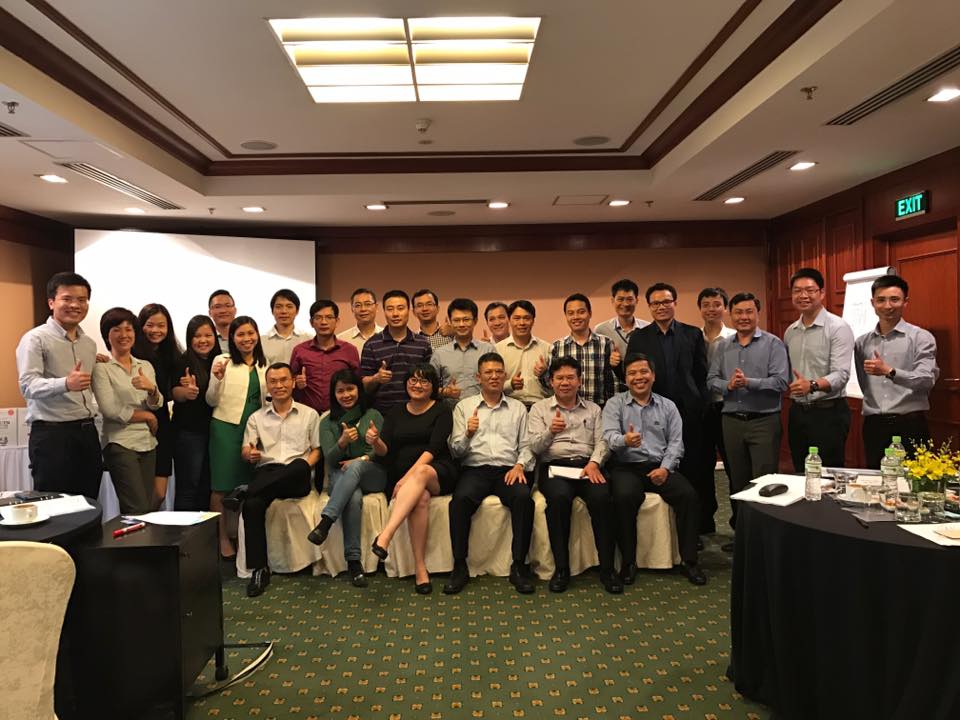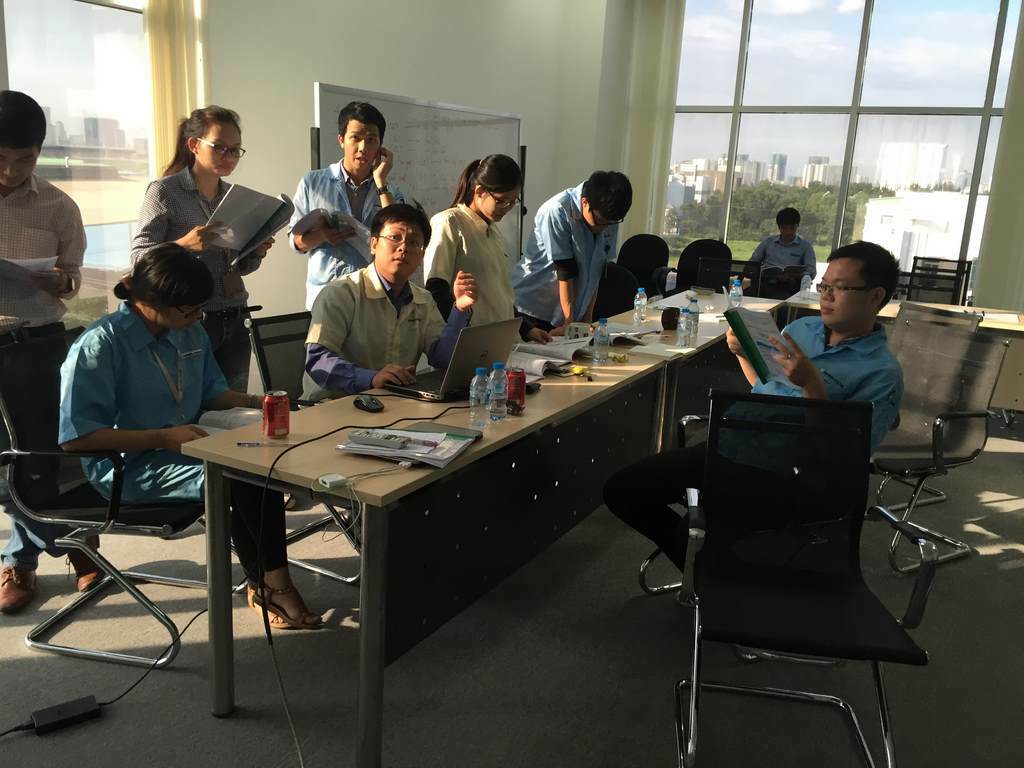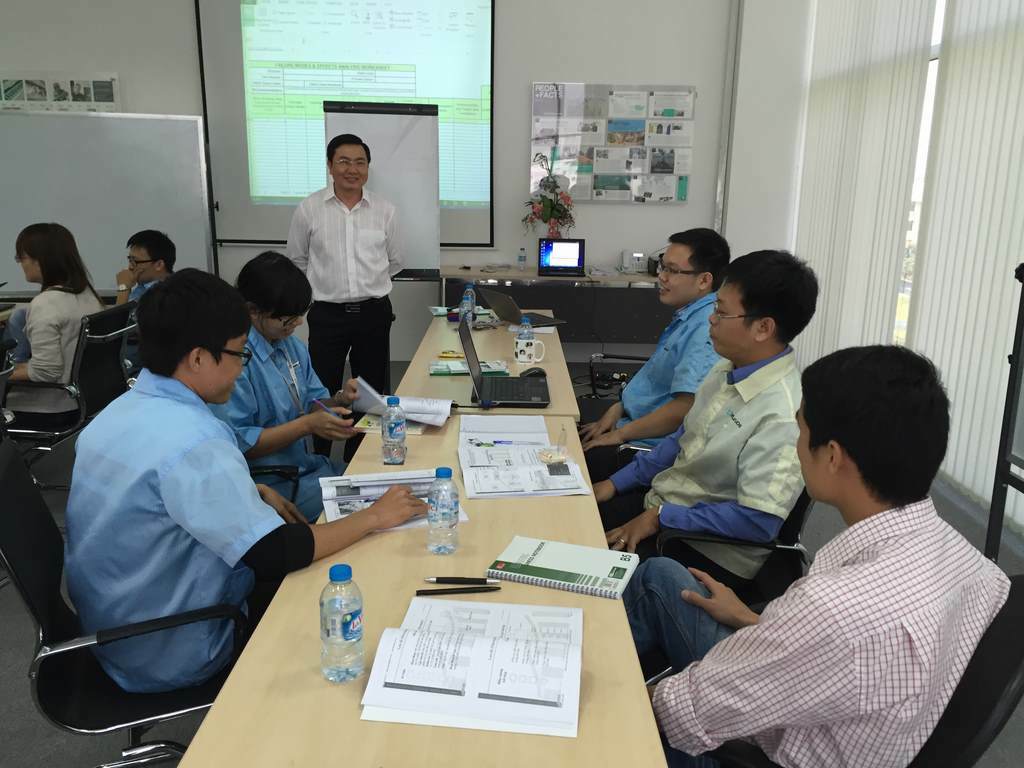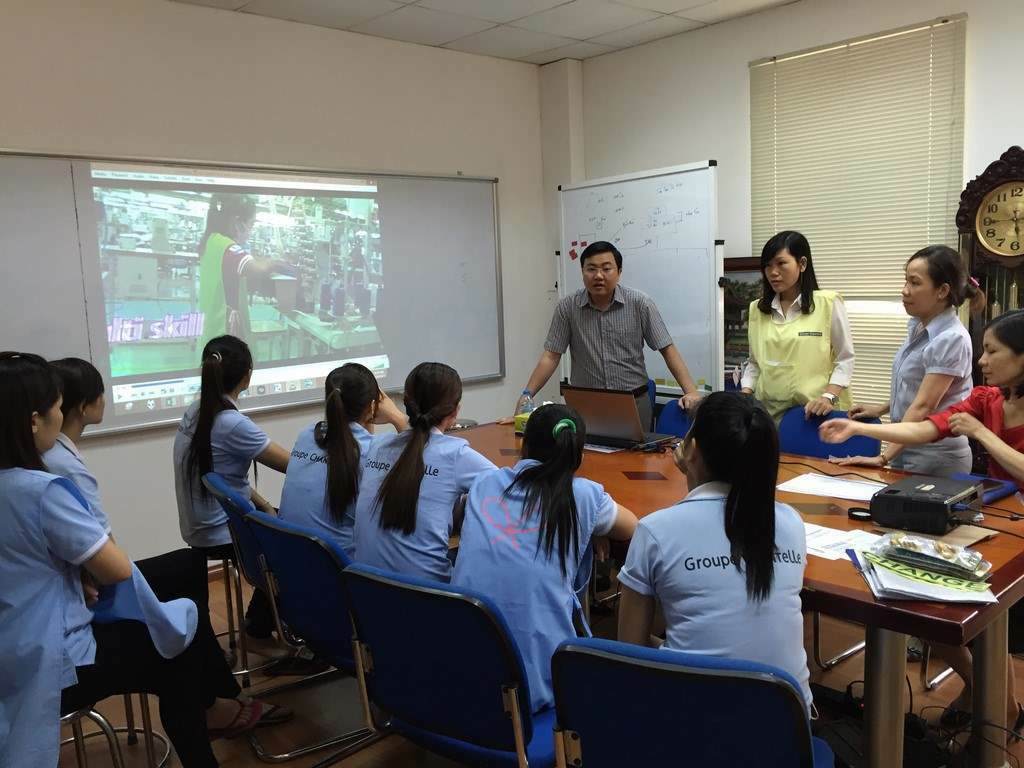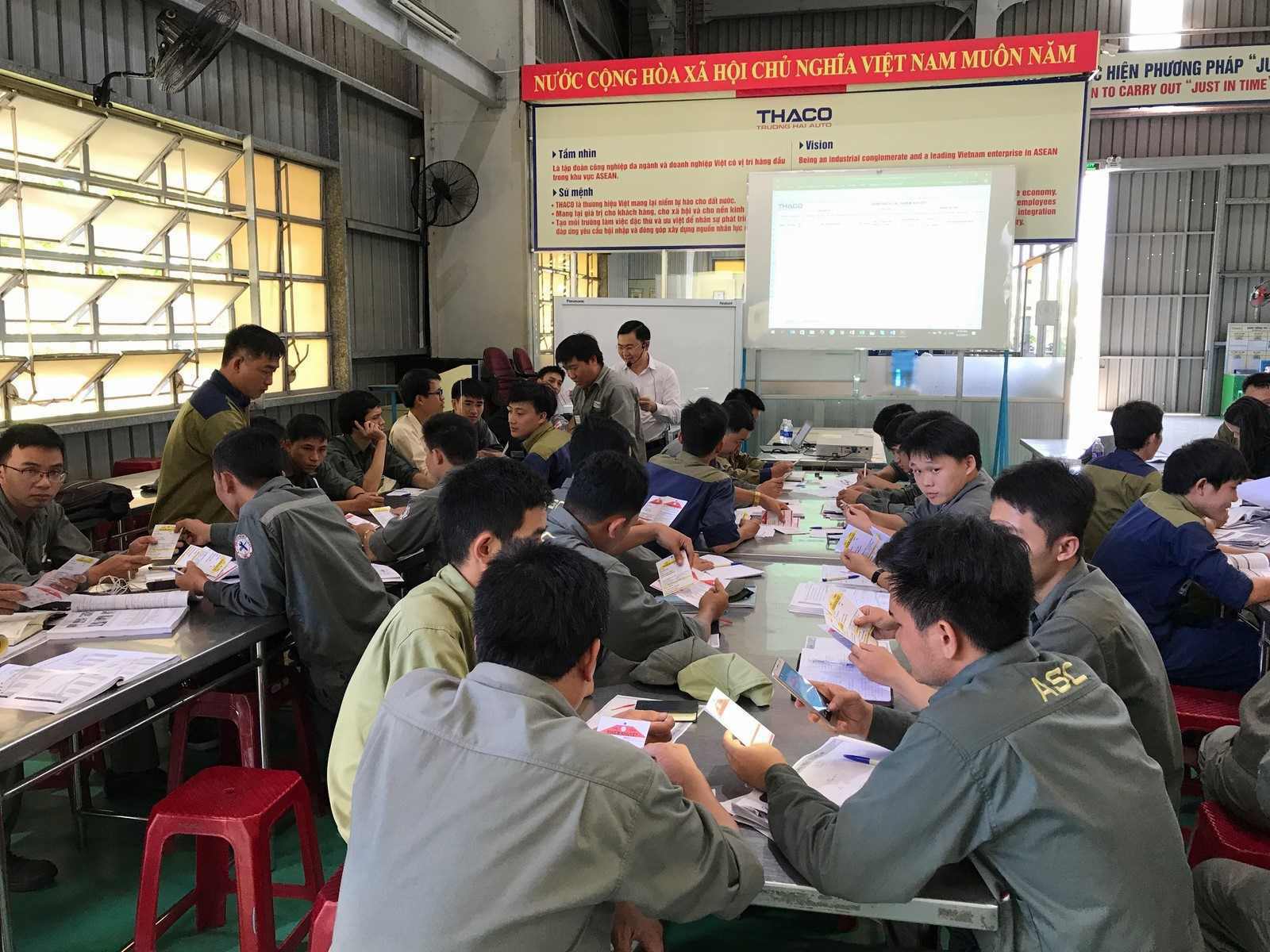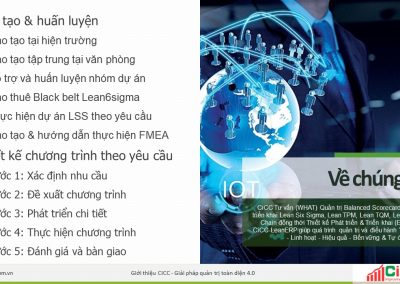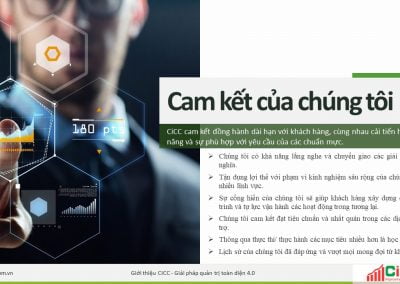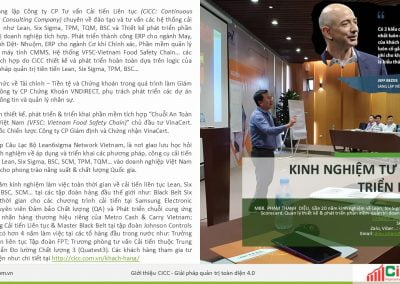Bản chất của lý thuyết các điểm hạn chế (Theory of Constrainst – TOC) là ở chỗ công suất của bất cứ dây chuyền sản xuất nào cũng bị quyết định bởi mắt xích yếu nhất trong dây chuyền đó. Mỗi hệ thống đều có những hạn chế ngăn cản các công ty hoàn thành mục tiêu sau cùng của mình.
 Lý thuyết các điểm hạn chế cho rằng bằng việc xóa bỏ hạn chế lớn nhất, công suất của toàn bộ hệ thống sẽ được tăng lên và nhờ đó sản lượng có thể tăng thêm.
Lý thuyết các điểm hạn chế cho rằng bằng việc xóa bỏ hạn chế lớn nhất, công suất của toàn bộ hệ thống sẽ được tăng lên và nhờ đó sản lượng có thể tăng thêm.
TOC tìm kiếm hạn chế trong hệ thống và loại trừ nó. Điều này đạt được bởi mỗi dây chuyền sản xuất không thể chạy nhanh hơn khâu chạy chậm nhất, nếu có hàng tồn kho sẽ chất đống. Sử dụng nguyên lý cái trống-vật đệm-sợi dây để kiểm soát nhịp độ của dây chuyền sản xuất.
Điểm hạn chế đóng vai trò như cái trống, quyết định nhịp độ, với các phương thức của sợi dây các công đoạn thô được hoạch định thế nào, còn vật đệm sẽ làm cho điểm hạn chế hoạt động trơn tru.
Trong cuốn The Goal, Goldratt và Cox đã mô tả nguyên lý này bằng hình ảnh một đoàn hướng đạo sinh, họ không thể đi đều với vận tốc nhanh hơn người đi chậm nhất. Nếu họ cố làm vậy, hàng lối sẽ kéo dài bởi mọi người đều vượt lên trước.
Đoàn người có thể đi đều liền nhau hơn nếu họ đi với tốc độ của người đi chậm nhất. Cả đoàn sẽ đi nhanh hơn nếu người chậm nhất đó có thể đi nhanh hơn.
Sử dụng lý thuyết TOC khi nào
TOC được sử dụng để tối đa hóa công suất của một dây chuyền sản xuất. Mục tiêu cuối cùng là tạo ra lợi nhuận, vì thế tập trung vào những chỉ báo khác nhau về sản xuất và tài chính để đạt được nững mục tiêu này.
- Công suất, sự khách biệt giữa dòng tiền vào và dòng tiền ra
- Tồn kho, tất cả các công cụ tài chính được đầu tư vào hệ thống để có được tài sản
- Chi phí hoạt động, tất cả các chi phí cần để biến hàng tồn kho thành sản phẩm cho người tiêu dùng.
Goldratt và Cox cho rằng để tạo ra nhiều lợi nhuận nhất có thể, công suất của hệ thống cần được tối đa hóa. Sự tập trung vào hoạt động sản xuất sẽ góp phần cải thiện thời gian, nhịp độ công việc chứ không chỉ cắt giảm chi phí.
Nếu được áp dụng đúng, TOC có thể giúp tránh được những lỗi thường gặp gây ra bởi chính tư duy hiệu quả thay vì tối đa hóa công suất của những máy móc đắt tiền nhất trong dây chuyền để giảm tối đa sản phẩm, sẽ hiệu quả hơn nếu tăng cường công suất của những máy móc cũ đã hết khấu hao.
Sử dụng lý thuyết các điểm hạn chế thế nào
TOC tập trung vào cải tiến dây chuyền. Một dây chuyền được định nghĩa là một chuỗi những quy trình phụ thuộc lẫn nhau. Mối liên hệ trong một hệ thống là một chuỗi các mắc xích cùng hoạt đọng hướng đến mục tiêu cuối cùng.
Điểm hạn chế chính là mắt xích yếu. Hoạt động của cả chuỗi bị giới hạn bởi hiệu quả của mắt xích yếu nhất. Trong quy trình sản xuất, TOC tập trung vào mắt xích làm chậm hiệu suất của cả quy trình.
Có năm buớc trong lý thuyết các điểm hạn chế.
- Xác định các điểm hạn chế trong hệ thống, các điểm hạn chế được xác định bằng các phương pháp khác nhau, số lượng công việc đang nằm chờ trong một quy trình hoạt động chính là chỉ báo về điểm hạn chế. Một ví dụ khác là khi sản phẩm được sản xuất theo lô
- Xác định các điểm hạn chế có thể mắc phải, khi điểm hạn chế đã được xác định, quy trình sẽ được cải tiến hoặc hỗ trợ nhằm đạt được công suất tối ưu mà không cần phải sữa chữa hay nâng cấp đáng kể nào. Nói cách khác, điểm hạn chế được khai thác tối đa.
- Gắn kết tất cả các vấn đề phụ thuộc vào quyết định thực hiện ở bước 2, khi quy trình mang điểm hạn chế hoạt động với công suất tối đa, tốc độ của các quy trình phục thuộc khác sẽ được cải thiện theo tốc độ hoặc công suất của điểm hạn chế.
Cần hy sinh hiệu quả của một số quy trình riêng biệt cho lợi ích của cả hệ thống. Trong chuỗi giá trị, những quy trình phụ thuộc thường nằm trước điểm hạn chế. Những quy trình nằm sau điểm hạn chế thường không liên quan nhiều lắm, có thể đã hoạt động dưới năng suất của cả hệ thống do phải chờ đợi các công việc tại quy trình có điểm hạn chế.
- Tăng cường hoặc phá vở điểm hạn chế trong hệ thống, nếu công suất của toàn bộ hệ thống vẫn chưa đạt yêu cầu, cần có những cải tiến hơn nữa. Công ty có thể áp dụng những thay đổi đáng kể với điểm hạn chế. Thay đổi có thể liên quan đến tăng cường vốn, tái cơ cấu hoặc đầu tư lớn hơn về thời gian hay tiền bạc. Bước này được gọi là nâng cấp điểm hạ chế hoặc thực hiện bất kỳ hành động cần thiết nào để xóa bỏ hạn chế đó.
- Ngay khi điểm hạn chế đã được khắc phục, quay trở lại bước 1, không được để sự trì trêntạo ra điểm hạn chế mới trong hệ thống, ngay khi điểm hạn chế đầu tiên bị loại bỏ, những phần khác trong hệ thống hoặc chuỗi quy trình lại sẽ trở thành điểm hạn chế mới. Đó chính là lúc lặp lại quy trình cải tiến.
Hoạt động của toàn bộ hệ thống được đánh giá lại bằng việc tìm kiếm điểm hạn chế mới, khắc phục, gắn kết các quy trình phụ thuộc và mở rộng công suất.
Bằng việc tập trung vào các điểm hạn chế, phương pháp này tạo ra hiệu quả tích cực đối với thời gian sản xuất hoặc phục vụ của một hệ thống. Cắt giảm lãng phí bằng cách tăng đầu vào và rút ngắn thời gian. Khi điểm hạn chế được khắc phục, dung sai giảm và chất lượng tăng. Tập trung vào điểm hạn chế không đòi hỏi hiểu biết chi tiết về phân tích dữ liệu, hoặc nhiều người hiểu được các yếu tố trong hệ thống mà chỉ cần một số ích người có đủ quyền lực để thay đổi nững yếu tố đó. Nổ lực có thể được tập trung với sự tham gia tối thiểu nhân lực trong công ty.
Khi thực hiện những bước trên, cần lưu ý rằng có hai loại hạn chế.
- Hạn chế nội bộ, những hạn chế trong giới hạn của hệ thống và tổ chức đã ngăn cản nó đạt mục đích. Ví dụ, không đủ công suất hoặc những hạn chế về quản lý và hành vi.
- Hạn chế từ bên ngoài: những hạn chế nằm ngoài giới hạn của hệ thống ngăn cản nó đạt mục đích. Ví dụ, giảm cầu, dư thừa sản phẩm và cạnh tranh.
Goldratt thường xuyên sử dụng phương pháp cây thực tế (Current Reality Tree – CRT) với hiệu ứng không mong đợi (Undesired Effect – UDE) để tìm ra điểm hạn chế và hướng giải quyết tối ưu. Những kỹ thuật này được trình bày trong cuốn sách Not Lucky của ông.
Kết luận
Tìm kiếm và xác định điểm hạn chế là một trong những yếu tố quyết định trong lý thuyết các điểm hạn chế. Bằng các này, hàng hóa tồn kho, sai sót và ngưng trện sản xuất được phân tích. Tuy nhiên, không nên chỉ xem xét khía cạnh logic và kỹ thuật của các điểm hạn chế, những yếu tố tổ chức và thông tin cũng khá quan trọng.
Phương pháp TOC hoạt động dựa trên một vài giả thuyết sau:
- Trong sản xuất tinh gọn, giá trị của các công ty chính là tốc độ mà sản phẩm và dịch vụ chạy trên hệ thống. Tốc độ và sản lượng chính là yếu tố quyết định thành công.
- Những quy trình hiện thời đều cần thiết để sản xuất sản phẩm mong muốn.
- Thiết kế của các sản phẩm và dịch vụ ổn định.
Những người công nhân trực tiếp làm tăng giá trị không cần phải hiểu sâu phương pháp cải tiến này. Những đề nghị họ đưa ra không phải là yếu tố sống còn để thực hiện thành công lý thuyết điểm hạn chế.
Những công ty có cơ cấu tổ chức kểu tập quyền và chỉ huy thường đánh giá cao phương pháp này.
Nhược điểm chính của TOC là điểm hạn chế có thể thay đổi, vì một day chuyền có thể sản xuất rất nhiều loại sản phẩm khác nhau. Tùy thuộc vào thời gian sản xuất, điểm hạn chế có thể khác nhau đối với những sản phẩm khác nhau. Hơn nữa, nhiều loại sản phẩm cho thấy có sự biến thiên thời gian, công suất và lượng hàng tồn kho. TOC chỉ xem xết yếu tố công suất. Tuy nhiên, nếu sự biến thiên bị bỏ qua, việc gia tăng số lượng bán hàng thành phẩm có thể xuất hiện và thời gian sản xuất cũng gia tăng, điều này hoàn toàn mâu thuẩn với mục tiêu.
Theo những mô hình quản trị kinh điển
“The chain is only as strong as its weakest link.”
The Theory of Constraints is a system philosophy which identifies the “weakest link” (constraint) and improves it.
Once the “weakest link” is improved, overall system performance is improved until the next “weakest link” is discovered.
Two types of constraints are:1) Physical and2) Policy or Procedure.
===============
Giới thiệu về Lý Thuyết của Những Sự Hạn Chế (tài liệu do Mekong capital cung cấp)
GỬI YÊU CẦU ĐĂNG KÝ
Khóa học 5S Kaizen
Khóa học kaizen 5S Khóa học nhận diện lãng phí và thực hành dự án kaizen P D C A tại MABUCHI MOTOR https://youtu.be/nqqJ2uTF-xw Giới thiệu khóa học Kaizen khóa học kaizen pdca GIỚI THIỆU CHƯƠNG TRÌNH: https://youtu.be/nVGkLjur2N4 Kaizen áp dụng thế nào cho phù hợp...
Khóa học thẻ đểm cân bằng BSC KPI OKR
Phương pháp tiếp cận cải tiến của CiCC Chúng tôi tự hào là đơn vị vừa kết hợp được giữa quản lý và định hướng chiến lược (WHAT) theo Balanced Scorecard (BSC) thiết lập mục tiêu Management By Objectives (MBO) chuyển đổi KPIs thành OKRs vừa là đơn vị hỗ trợ, tư vấn...
KHÓA HỌC ISO TS 16949 VÀ CÁC CÔNG CỤ CHÍNH (IATF 16949)
KHÓA HỌC VỀ CÔNG CỤ CHÍNH CỦA ISO / TS / IATF 16949 Tên khóa học Thời lượng Public On-site ATF01 - Advanced Product Quality Planning (APQP) 1 day N Y ATF02 - Failure Mode and Effects Analysis (FMEA) 3 days Y Y ATF03 - Production Part Approval Process (PPAP) 1 days N Y...
Khóa học Bảo trì TPM
khóa học bảo trì năng suất tổng thể TPM được CiCC thiết kế dựa trên kinh nghiệm triển khai cho các tập đoàn hàng đầu thế giới và ở Việt nam
KHÓA HỌC CHỨNG NHẬN ĐẲNG CẤP LEAN SIX SIGMA DMAIC
KHÓA HỌC CHỨNG NHẬN ĐẲNG CẤP SIX SIGMA CÁC ĐAI Tên khóa học Thời lượng Public On-site SSM01 - Six Sigma Black Belt Certification 20 days Y Y SSM02 - Six Sigma GB upgrade to BB Certification 10 days Y Y SSM03 - Six Sigma Champion Certification 3 days Y Y SSM04 - Six...
DỊCH VỤ ĐÀO TẠO & HUẤN LUYỆN
Đào tạo & Huấn luyện Lean Six Sigma
CiCC can help enhance your organization’s process improvement efforts through the effective application of Lean Six Sigma methods and tools.
What is Lean Six Sigma?
- Lean Six Sigma is a blend of two concepts: Lean, which is aimed at reducing waste by breaking down processes and segregating waste from value, and Six Sigma, which helps companies reduce process variation and errors by using quality and statistical tools. Together they help companies reap the benefits of faster processes with lower cost and higher quality.
- The type of process issues experienced by the organization will dictate the selection of the most suitable set of Lean and Six Sigma tools.
- Originally developed to improve manufacturing efficiency and quality, Lean Six Sigma is now being adopted by all types of organizations from financial institutions to retailers to hospitals.
Our approach to Lean Six Sigma
- CiCC’s integrated Lean Six Sigma consulting and training approach does not simply add a limited set of Lean tools to the Six Sigma DMAIC (Define, Measure, Analyze, Improve, Control) improvement methodology; instead, we go broad and deep, providing your organization with the full set of Lean tools, teaching and empowering you to select and use the tools that make the most sense for each situation.
Learn more about Lean Six Sigma training and consulting
CiCC starts by understanding what programs, if any, you already have in place (e.g., ISO 9000 compliant management system). Our experience enables us to evaluate objectively your existing performance improvement initiatives, identify the gaps, and then work together to deploy a high-impact Lean Six Sigma program.
Our experienced Lean Six Sigma consultants can help your organization:
- Decide which deployment model best suits your environment.
- Establish an effective governance structure.
- Identify opportunities (areas of focus) to apply the methodologies to enhance business performance.
- Select projects within the areas of focus.
- Train and coach your staff so that they correctly apply the tools.
- Monitor the overall performance of your Lean Six Sigma initiative, and identify opportunities for improvement.
Lean Six Sigma Training Solutions
- CiCC has a comprehensive suite of Lean Six Sigma training to meet the needs of various audience groups throughout an organization.
- We regularly hold public classes on Lean Six Sigma related topics in more than 5 cities around the Vietnam. In addition, each of our courses can be customized and presented at a location of your choice. For groups of five or more, on-site classes are a cost-effective, flexible, confidential way to train your employees. You can trust our highly-skilled trainers to transfer the knowledge to your staff effectively and efficiently.
- Our Lean Six Sigma training programs also are available in multiple versions to suit industry-specific needs, such as manufacturing, services, and healthcare.
Our standard training courses include those listed below:
| Course name | Duration | Public | Onsite |
| Lean Six Sigma Black Belt Certification | 20 days | Y | Y |
| Lean Six Sigma GB upgrade to BB Certification | 10 days | Y | Y |
| Lean Six Sigma Champion Certification | 3 days | Y | Y |
| Lean Six Sigma Green Belt Certification | 10 days | Y | Y |
| Lean Six Sigma Master Black Belt Certification | 10 days | Y | N |
| Lean Six Sigma White Belt | 5 days | Y | Y |
| Lean Six Sigma for Management | 1 day | Y | Y |
| Lean Six Sigma Awareness | 2 days | Y | Y |
| Lean Six Sigma Project Support | 5 days | N | Y |
| Lean Six Sigma Audit and Assessments | 2-5 days | N | Y |
Đào tạo & Huấn luyện Lean/ Kaizen / Just In Time
CiCC has taken the basics of Lean and has made them even more practical and accessible to practitioners in any industry at any level. Our Lean methodology approach focuses on developing staff to reach strategic goals that help your organization improve and make value flow faster.
What Is Lean?
The Lean methodology and tools are based on the Toyota Production System that focuses on the complete elimination of all waste, efficient production, and collaborative teamwork at all levels of the organization. The goal of Lean is to produce the right amount (based on demand) of high-quality products and services (as defined by your customers) with the least amount of time, effort, and cost. This system has now been adapted and adopted by all types of organizations. Manufacturing, financial, healthcare, insurance, government, and military institutions have all embraced Lean.
CiCC’s Lean Pathway for Deployment
- CiCC offers an innovative application of Lean concepts and methodologies through our Lean Pathway model.
- This model helps you utilize the appropriate Lean methodology manufacturing approach based on the problem being solved; it serves as a guide for determining when to use a particular Lean approach and, it addresses the support systems issues that must be managed to make Lean a sustainable part of the business culture, not just a temporary tool set.
- CiCC Lean experts have a long history of applying Lean in a vast array of industries, including healthcare, financial services, industrial, and government.
- Our strength lies in the depth of knowledge and experiences our Lean training team brings to the customers we serve.
CiCC Consultants Can:
- CiCC offers an innovative application of Lean concepts and methodologies through our Lean Pathway model.
- Our Lean Pathway is designed to speed up Lean deployment and help an organization progress from an isolated project-type implementation to a more comprehensive transformation-based implementation.
- Like the more rigorous methods found in other improvement initiatives, such as Six Sigma, the Lean Pathway is both prescriptive- suggesting a logical sequence of implementing Lean- and flexible enough to be useful in diverse situations.
Lean Training Solutions
CiCC’s comprehensive suite of Lean training solutions ensures all needs are met at every level of your organization- from your suppliers to the CEO, from you into the hands of your customers.
In addition to offering standard programs, Lean training courses can be customized to meet your organization’s unique goals. Our training programs also are available in multiple versions to suit industry-specific needs, such as manufacturing, services and healthcare.
Our standard training courses include those listed below:
| Course Name | Duration | Public | On-site |
| Lean Practitioners Certification | 8 days | N | Y |
| Lean Implementer Certification | 12 days | Y | Y |
| Planning and Leading Lean Kaizen Events | 4 days | Y | Y |
| Targeted Lean Event | 4 days | N | Y |
| Understanding Lean Enterprise Tools | 1-2 days for each Tool | Y | Y |
| Lean for Management | 1 day | Y | Y |
| Lean Awareness Manufacturing / Service | 3 days | Y | Y |
| Lean Project Support | 5 days | N | Y |
| Lean Audit and Assessments | 2-5 days | N | Y |
| Creating and Computerizing the Lean Office | 2 days | Y | Y |
| Lean Performance Measurements | 2 days | Y | Y |
Đào tạo & Huấn luyện Dư án Six Sigma DMAIC
DMAIC is a step-by-step approach for improving existing business processes.
The Six Sigma methodology, DMAIC (Define, Measure, Analyze, Improve, Control), is used when a product or process is in existence but is not meeting customer specifications or is not performing adequately. The Six Sigma DMAIC approach combines statistical and quality management tools to ensure that processes exhibit peak performance, resulting in a dramatic increase in customer satisfaction, productivity, and shareholder value.
The successful deployment of Six Sigma DMAIC requires the application of a wide range of tools, from simple quality tools (e.g., brainstorming or Pareto analysis) to advanced statistical modeling (e.g., regression analysis or designed experiments). The goal is to boost performance, drive better solutions and drastically reduce or eliminate nonconformities (defects) and problems to exceed customer requirements.
CiCC’s Six Sigma consultants can help you apply Six Sigma DMAIC to its fullest extent.
Our experienced Six Sigma consultants can help your organization:
- Establish an effective governance structure for the DMAIC strategy.
- Facilitate strategic planning sessions.
- Select, review, and evaluate projects that are aligned with the organization’s strategy.
- Develop your organization’s Six Sigma Champions, with Black Belts, and Green Belts, including providing “Train the Trainer” programs.
- Complete Six Sigma projects by providing on-site coaching and assistance for project Champions.
- Bring the benefits of Six Sigma to your organization right away through our Rent-a-Black Belt program.
- Train and coach your staff so that they correctly apply the DMAIC and/or DMADV tools.
- Monitor the overall performance of your Six Sigma initiative and identify opportunities for improvement.
DMAIC Training Solutions
Our programs may be customized for your organization within your Six Sigma process improvement effort. In addition, our Six Sigma training programs also are available in multiple versions to suit industry-specific needs, such as manufacturing, services, and healthcare.
Our standard training courses include those listed below:
| Course name | Duration | Public | Onsite |
| Six Sigma Black Belt Certification | 20 days | Y | Y |
| Six Sigma GB upgrade to BB Certification | 10 days | Y | Y |
| Six Sigma Champion Certification | 3 days | Y | Y |
| Six Sigma Green Belt Certification | 10 days | Y | Y |
| Six Sigma Master Black Belt Certification | 10 days | Y | N |
| Six Sigma White Belt | 5 days | Y | Y |
| Six Sigma for Management | 1 day | Y | Y |
| Six Sigma Awareness | 2 days | Y | Y |
| Six Sigma Project Support | 5 days | N | Y |
| Six Sigma Audit and Assessments | 2-5 days | N | Y |
Đào tạo & Huấn luyện Design for Six Sigma DMADV
Six Sigma DMADV provides the road map for process (re)design and helps you to create and implement an effective process from the start.
Design for Six Sigma applies the DMADV (Define, Measure, Analysis, Design, Verify/Validate), methodology. The successful deployment of Six Sigma DMADV results in products and services that consistently meet customer requirements, projected costs, targeted release dates, and production capabilities.
The successful deployment of Six Sigma DMADV requires the application of a wide range of tools, from simple quality tools (e.g., brainstorming or Pareto analysis) to advanced statistical modeling (e.g., regression analysis or designed experiments). The goal is to boost performance, drive better solutions and drastically reduce or eliminate nonconformities (defects) and problems to exceed customer requirements.
CiCC’s consultants can help you apply Design For Six Sigma DMADV to its fullest extent.
Our standard training courses include those listed below:
| Course Name | Duration | Public | On-site |
| Design for Six Sigma | 1-5 days | Y | Y |
| Applying Six-Sigma to Product Development | 5 days | Y | Y |
Đào tạo Công cụ Cải tiến Focused Improvement Tools
Focused Improvement Tools (FIT) constitute an CiCC approach to Lean Six Sigma deployment that allows you to “jump start” or enhance your Lean Six Sigma program by isolating the application of rigorous statistical tools into stand-alone courses.
In contrast to traditional, multiple-week programs such as Black Belt training, FIT courses offer 2-3 days of in-depth training focused on mastering the specific Lean Six Sigma tool you need right away. This more focused approach allows individual practitioners to learn (or refresh) targeted skills that can be applied quickly to solve their process issues, and allows organizations to see a faster return on investment by breaking down big, bold objectives into smaller, more achievable chunks.
Benefits of the Focused Improvement Tools program include:
- Matches the right Lean Six Sigma tool with an organization’s specific needs.
- Allows organizations to accelerate deployment of the specific skills they need in order to streamline processes and enhance returns.
- Participants see a faster return on investment by focusing on their most needed Lean Six Sigma tool.
- For organizations already using Lean Six Sigma as a tool, offers an opportunity to brush up or delve deeper into specific important skills.
- Is an optimal starting place for employees who don’t have time for longer Lean Six Sigma courses.
- Courses can be taken on their own or bundled together in cost-saving packages.
If your organization needs immediate assistance applying a single or series of Focused Improvement Tools, an CiCC consultant can help.
Our standard training courses include those listed below:
Course Name | Duration | Public | On-site |
Applying Design of Experiments (DOE) | 3 days | Y | Y |
Basic Problem Solving (Root Cause Analysis) | 2 days | Y | Y |
Basic Statistics/Introduction to Minitab | 3 days | Y | Y |
Conducting Regression Analysis | 2 days | Y | Y |
Data Collection and Gage R&R (MSA) | 2 days | Y | Y |
Implementing Statistical Process Control (SPC) | 3 days | Y | Y |
Potential Failure Mode and Effects Analysis (FMEA) | 3 days | Y | Y |
Understanding and Conducting Data Analysis | 3 days | Y | Y |
Understanding and Measuring Process Performance | 2 days | Y | Y |
Understanding and Performing Hypothesis Testing | 2 days | Y | Y |
Cost of Quality (COQ) Implementation | 2 days | Y | Y |
Quality Function Deployment (QFD) | 2 days | Y | Y |
Policy Deployment | 2 days | Y | Y |
Đào tạo & Huấn luyện ISO TS 16949 Core Tools
The quality core tools will help you improve your organization’s QMS. Companies seeking TS 16949 need to understand the core tools to meet the requirements. The 5 Core Tools required to effectively implement and audit ISO/TS 16949 are listed in the table below.
- Advanced Product Quality Planning (APQP)
- Failure Mode and Effects Analysis (FMEA)
- Production Part Approval Process (PPAP)
- Statistical Process Control (SPC)
- Measurement System Analysis (MSA)
CiCC’s consultants can help you apply TS16949 core tools to its fullest extent.
Our standard training courses include those listed below:
Course Name | Duration | Public | On-site |
Advanced Product Quality Planning (APQP) | 1 day | N | Y |
Failure Mode and Effects Analysis (FMEA) | 3 days | Y | Y |
Production Part Approval Process (PPAP) | 1 days | N | Y |
Statistical Process Control (SPC) | 3 days | Y | Y |
Measurement System Analysis (MSA) | 2 days | Y | Y |
Đào tạo & Huấn luyện Balanced Scorecard
CiCC provides training and consulting services to commercial, government, and non-profit organizations. We applies best practices gained from hundreds of consulting assignments and thousands trainees in Balanced scorecard, strategic performance management and measurement, strategic planning, and change management to help executives, managers and analysts transform their organizations into “performance excellence” organizations.
Our standard training courses include those listed below:
Course Name | Duration | Public | On-site |
Introduction to the Balanced Scorecard | 2 days | Y | Y |
Advanced Balanced Scorecard | 3 days | Y | Y |
Practice and application Balanced Scorecard | 3 days | Y | Y |
Build up Balanced Scorecard system | 3 days | Y | Y |
Đào tạo & Huấn luyện Supply Chain Management
Consulting in Supply Chain & Operation is project based designing new systems, researching specific markets or improving organizations.
CiCC provides training and consulting in supply chain management.
Beside Lean Six Sigma, we combine Lean to supply chain to Lean supply chain management is for many companies. It is not just for manufacturers who practice lean management. It is also for non-manufacturers, wholesalers, distributors, retailers and others
CiCC’s consultants can help you apply Supply Chain to its fullest extent.
Our standard training courses include those listed below:
Course Name | Duration | Public | On-site |
Supply Chain Strategies | 2 days | Y | Y |
Internet Technologies and Supply Chain Management | 3 days | Y | Y |
Performance Measures for Supply Chain Management | 3 days | Y | Y |
Product and Process Design for Supply Chain Management | 3 days | Y | Y |
Thực hiện Đánh giá Performance Excellence
Performance excellence—the ability to create value for customers, employees, and investors—is a common theme among the best performing organizations in the world.
CiCC’s Performance Excellence Practice helps organizations create sustainable value by addressing the needs of those three key groups.
- Sustainable Performance Management
- Teams
- Assessment Services
In addition to providing directed Performance Excellence consulting services, we offer a comprehensive suite of Performance Excellence training courses. All of our Performance Excellence courses can be customized for your organization.
Our standard training courses include those listed below. Refer to any course title for more information at www.cicc.com.vn
Course Name | Duration | Public | On-site |
Optimizing Teams for Success | 1 days | N | Y |
Lean Assessments | 2 days | N | Y |
Six Sigma Assessments | 2 days | N | Y |
Lean Six Sigma Assessments | 2-5 days | N | Y |
Enterprise Performance Diagnosis | 2-5 days | N | Y |
ĐĂNG KÝ CẬP NHẬT
GỬI THÔNG TIN LIÊN HỆ
CÔNG TY CP TƯ VẤN CẢI TIẾN LIÊN TỤC – CiCC
- Địa chỉ: Lầu 6, Master Building, 41 – 43 Trần Cao Vân, Phường 6, Quận 3, Tp.HCM
- Trung tâm Đào tạo & Huấn luyện: Lầu 5, 68-70 Hoàng Diệu, P.12, Q.4, Tp.HCM
- Tel: 028 5422 1148
- Fax: 028 5422 1149
- Hotline: 085 636 1008
- Mail: info@cicc.com.vn
- Web: www.cicc.com.vn www.leansigmavn.com www.lean.vn www.erpsolution.vn

TRƯƠNG THỊ PHƯƠNG DUNG

PHẠM THANH DIỆU














